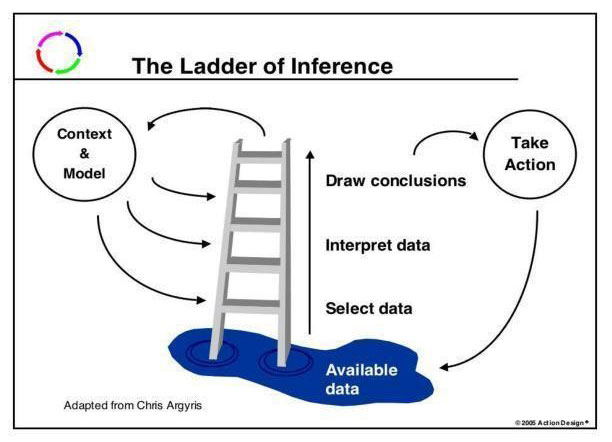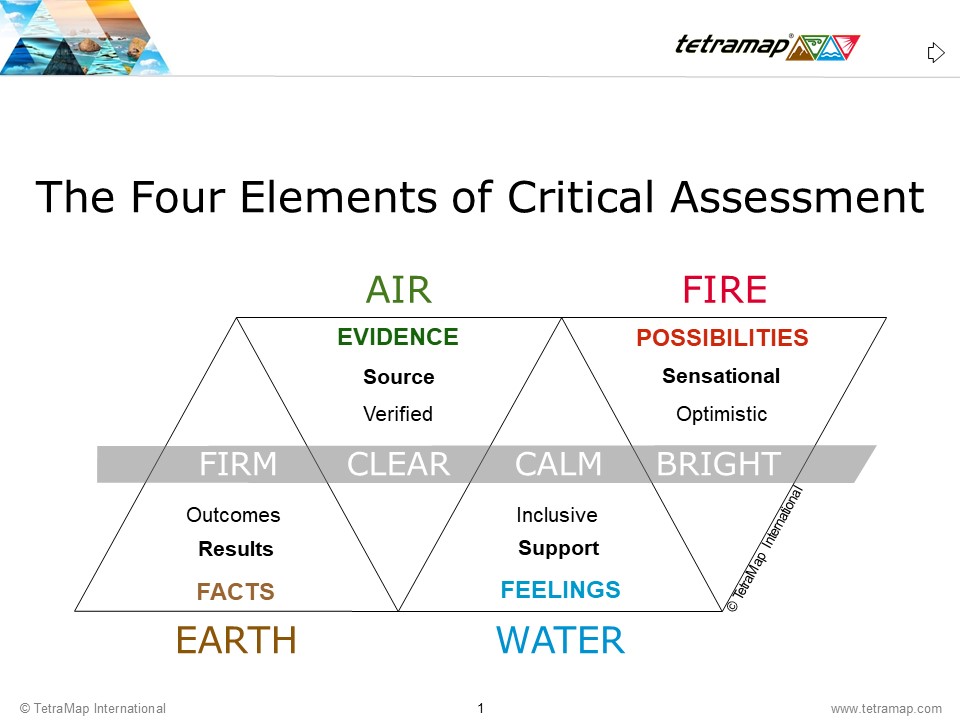Are you a conscious consumer…
of content?
By Jan Alley Master TetraMap Facilitator – 24 April 2020
Are you still plugging into the news every day? I know I’m certainly consuming less news than ever before. It’s all become a bit too much – too repetitive, too divisive, too back and forwards from one camp to the other.
The COVID-19 pandemic has highlighted how living in the information age can be overwhelming as we are inundated with content from multiple sources through multiple channels.
To protect our well-being and save our sanity, the ability to be selective with information we access, process and accept is more important than ever before. It’s up to us as the receiver of information to choose reliable sources and separate fact from opinion, speculation and misinformation – as the sender may often disguise those differences. We need to step up and start being conscious consumers of content.
But how do we do that?
First Check Point – Analyse and Evaluate
Critical thinking skills vary across each of us, but they are skills that can be learned. The first step is an awareness that we have the ability to objectively analyse and evaluate information to form a judgement. It starts with identifying what actual facts and real data are.
Obviously with the rest of the world at a stand still the media and commentators are seeking fresh angles on the coronavirus pandemic – constantly interviewing experts and specialists who offer some facts, and a lot of opinion. Predictions and modelling can also be misleading. Although based on facts, they are not reality. They are only indications of what may, or may not, be real in the future.
Social media also provides endless opportunities for the promotion of individual opinions, thoughts and ideas. Endless internet hoaxes, websites, articles, tweets, photos, videos, GIFs and memes are created every day about things that are often somewhat, or completely fake. This is dangerous as we are inclined to instantly believe what we see, read or hear. Younger generations, who are spending much more time online than each generation before them, are even more susceptible to this.
So much so that ‘fake hoax’ websites like The Pacific Northwest Tree Octopus and Human Meat Found at McDonald’s Factory are being created to educate school students on how to evaluate information, a brand new subject at school that has now become vital.
The initial understanding that not every piece of content or information we consume is based in truth is an important lesson. But what happens if we do latch on to a piece of information that isn’t factual?
Danger Zone – the Ladder of Inference
Observing the deluge of ideas on coronavirus prompted me to reflect on the Ladder of Inference, proposed by Chris Argyris and Peter Senge in the 1970’s. The model demonstrates how the brain starts with a piece of data (a comment made to you, something that you have observed or read, an expert’s opinion), and quickly progresses through a series of mental steps to reach a conclusion that influences your beliefs and actions.
The most powerful, and terrifying, learning is that the steps take place inside your head, often without realising you have only selected some of the data, or have quickly assigned a conclusion that may not be based on real facts.
 Because the brain tends to compartmentalise or put things into boxes, once we take a position at the base of the ladder, we often only seek additional data that confirms our position to step up. We find opinions similar to our own, people we like to agree with, information that reinforces our judgments – without realising how biased our judgments may be. Before long we’re all the way up the ladder and we’re making big decisions (and often sharing these with others) before checking ourselves, or testing the information input along the way.
Because the brain tends to compartmentalise or put things into boxes, once we take a position at the base of the ladder, we often only seek additional data that confirms our position to step up. We find opinions similar to our own, people we like to agree with, information that reinforces our judgments – without realising how biased our judgments may be. Before long we’re all the way up the ladder and we’re making big decisions (and often sharing these with others) before checking ourselves, or testing the information input along the way.
Political debates provide great examples of climbing the ladder without checking data or looking for contrary evidence. An extreme version is when you support a political party, then decide everything they do is right and everything the opposition does is wrong, without analysing or evaluating information. It’s as if you’re assuming the party or politician is doing that analysis for you, rather than just promoting their own political agenda. It sounds obvious now, doesn’t it? Supporters versus opponents of President Trump are a great example of this. I don’t think I need to expand that example.
The great toilet paper rush
“There is a danger that as we stay in our bubbles, both physical and virtual, we fall into ‘echo chambers’ wherein we only hear similar voices and opinions to our own.” New Zealand Herald 12 April 2020 refers to the risk of social isolation furthering narrow views. Another example of leaping up that ladder was the panic buying of items like toilet paper. Official government sources stated that toilet paper would not run out, as it is produced in New Zealand and there was ample supply. They stated this multiple times. However, people heard from “someone” that we were going to run out, or saw others stockpiling, and ignored all official advice as they rushed out to fill their trolleys with cotton-softs.
So what can we do to check ourselves at each rung? Contrary evidence enables us to test our position or broaden our outlook. By seeking different opinions and perspectives or alternative theories we create a balanced foundation to move up the ladder and make informed decisions. The two opposing views provided in Siouxsie Wiles vs Plan B are an example of contrary evidence that gives the reader the opportunity to make their own balanced judgement.
Check, challenge and contradict yourself before you climb too high to get back down.
Create a Balanced View – TetraMap®
Determining all information you receive is factual, and checking you’re always open to contrary evidence will set you on the right path, but we can take it one step further and approach issues with a range of viewpoints. This not only helps you process information from a balanced point of view, it also helps you communicate and empathise with others who may have varying viewpoints to your own.
The TetraMap® of Behaviour is a model that enables you to broaden your understanding of a situation by viewing an issue from different points of view. TetraMap uses the metaphor of nature by mapping the basic elements of earth, air, water and fire to provide four different perspectives or world views. Each of us have all four elements present, but one or two are much stronger and lead our behavioural preferences. When determining an opinion on something an individual will often start from the perspective of their highest behavioural preferences. However, with awareness, people can extend their own view by considering different views that are equal and complementary.
TetraMap can help us identify what factors influence individual decision making for each element:
- Ear
 th is firm, influenced by facts, results, outcomes and speed of change.
th is firm, influenced by facts, results, outcomes and speed of change. - Air is clear, influenced by the source of information, verification, evidence and research.
- Water is calm, influenced by concern for others, and a desire to help and support.
- Fire is bright, influenced by excitement, people they admire, sensationalism and an optimistic hope for change.
Then the same model can encourage each of us, no matter what element we are strongest in, to create a more balanced view by considering different perspectives:
- Earth is firm – What are the actual facts? What will deliver the results? What are the key outcomes here?
- Air is clear – Where is the evidence? What is the source? Has this been verified?
- Water is calm – How is this affecting people? What can we do to help and support? How can we make sure everyone’s opinions are heard?
- Fire is bright – Who is providing this information? How can we change and make improvements? How can I encourage more energy, or a more stimulating and lively debate?
What you can do
The challenge for us all as we enter an unknown and uncertain future is to seek accurate, balanced information and avoid being swept along torrents of speculation, exaggeration and misinformed judgements. Here are a few ways you can take control:
- Be selective in the information you access, process and accept
- Aim to separate fact from opinions and always check your sources
- Understand that predictions and modelling are not necessarily reality
- Be aware of how quickly you can move up the ladder, and check yourself before you climb too high
- Challenge yourself to question from different viewpoints, demonstrated by TetraMap elements
- Take care of your wellbeing and reduce a sense of being overwhelmed, by managing the quality and quantity of information you are exposed to